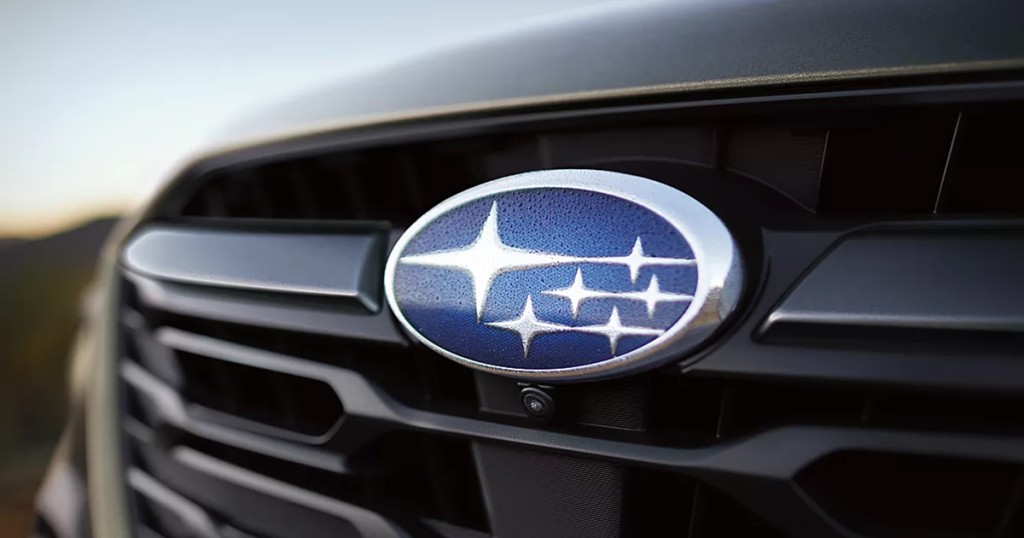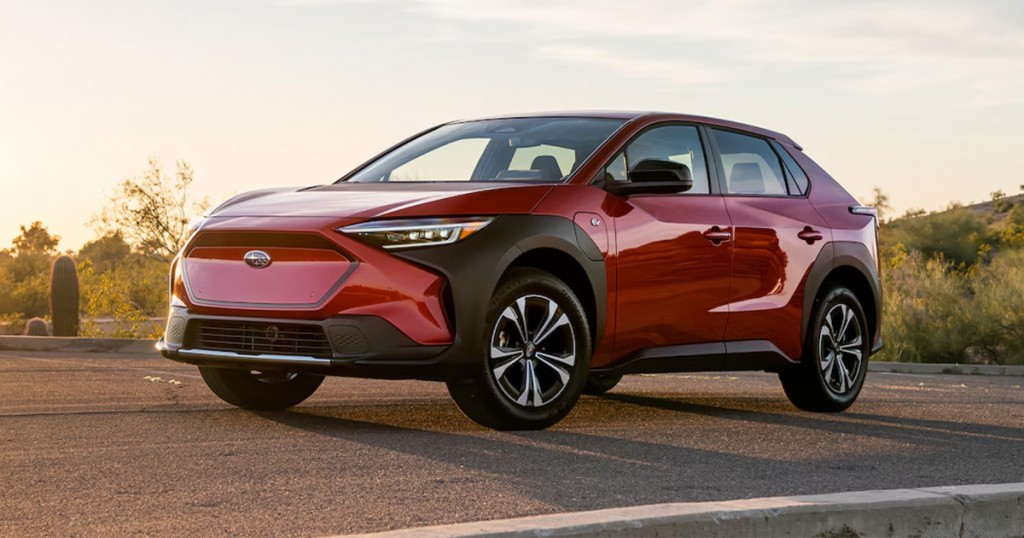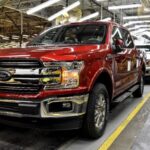Subaru Forester cars made are a testament to Subaru’s commitment to quality and reliability. This article, brought to you by CARS.EDU.VN, dives deep into the manufacturing origins of the Subaru Forester, exploring the plants where these popular SUVs are assembled and what makes them so special, providing you with insights on Forester production and quality assurance. Discover Forester production locations and the future of Subaru manufacturing.
1. Unveiling the Manufacturing Locations of the Subaru Forester
The Subaru Forester, a compact SUV celebrated for its blend of versatility, safety, and reliability, has garnered a devoted following worldwide. CARS.EDU.VN understands that prospective buyers and Subaru enthusiasts alike are often curious about the origins of their vehicles. Where exactly are Subaru Forester cars made?
As of the latest information available, the primary manufacturing location for the Subaru Forester is in Japan. Specifically, the Forester is predominantly produced at Subaru’s Gunma Main Plant in Japan.
- Gunma Main Plant, Japan: This is one of Subaru’s largest and most advanced manufacturing facilities.
While the majority of Foresters are manufactured in Japan, there have been instances where production was supplemented by other facilities to meet global demand. For example, Subaru has previously produced the Forester at its plant in Indiana, USA, Subaru of Indiana Automotive, Inc. (SIA), especially for North American markets. However, recent information indicates that the Forester production has been consolidated back to Japan.
2. A Closer Look at Subaru’s Gunma Plant: The Heart of Forester Production
Subaru’s Gunma Main Plant is not just a manufacturing facility; it’s a symbol of Subaru’s dedication to quality and innovation. The plant is equipped with state-of-the-art technology and adheres to stringent quality control measures.
2.1. Key Features of the Gunma Plant
- Advanced Robotics and Automation: The Gunma plant utilizes advanced robotics for precision welding, painting, and assembly.
- Integrated Quality Control: Each stage of the production process is closely monitored to ensure that every Forester meets Subaru’s high standards.
- Skilled Workforce: The plant employs a team of highly skilled technicians and engineers who are passionate about their craft.
- Environmental Considerations: Subaru is committed to sustainable manufacturing practices, and the Gunma plant incorporates eco-friendly technologies to minimize its environmental impact.
2.2. The Production Process: From Raw Materials to Finished Vehicle
The manufacturing of a Subaru Forester at the Gunma plant involves a complex and meticulously planned process:
- Stamping: Raw steel is stamped into body panels with incredible precision.
- Welding: Robotic welders join the panels to form the Forester’s robust body structure.
- Painting: The body undergoes a multi-stage painting process to ensure a flawless and durable finish.
- Assembly: The engine, drivetrain, interior components, and other parts are installed with meticulous care.
- Inspection: Every Forester undergoes a thorough inspection to identify and rectify any imperfections.
3. The Role of Subaru of Indiana Automotive (SIA) in Forester Production History
Subaru of Indiana Automotive, Inc. (SIA) has played a significant role in Subaru’s global production strategy. While the plant primarily focuses on producing models like the Outback, Legacy, and Ascent, it has also supplemented Forester production in the past.
3.1. SIA’s Contribution to Meeting Demand
- North American Market Focus: SIA has been instrumental in meeting the demand for Subaru vehicles in North America.
- Flexibility in Production: The plant’s flexible manufacturing capabilities have allowed Subaru to adjust production volumes based on market needs.
3.2. Why Production Locations Can Shift
The automotive industry is dynamic, and production locations can shift due to a variety of factors:
- Market Demand: Changes in demand for specific models can lead to adjustments in production locations.
- Economic Factors: Currency exchange rates, labor costs, and trade agreements can influence manufacturing decisions.
- Plant Capacity: Subaru may shift production to optimize the utilization of its global manufacturing capacity.
- New Model Introduction: The introduction of new models or redesigns can necessitate changes in production locations.
4. Why “Made in Japan” Matters: The Subaru Forester Advantage
The “Made in Japan” label carries significant weight in the automotive world. It is often associated with superior quality, reliability, and attention to detail.
4.1. The Japanese Manufacturing Philosophy
Japanese automakers are renowned for their commitment to excellence in manufacturing. Key principles include:
- Kaizen (Continuous Improvement): A relentless focus on identifying and implementing small improvements in every aspect of the production process.
- Lean Manufacturing: Minimizing waste and maximizing efficiency through optimized processes and resource utilization.
- Total Quality Management (TQM): Involving all employees in the pursuit of quality and customer satisfaction.
4.2. How These Principles Translate to the Forester
These principles translate to tangible benefits for Subaru Forester owners:
- Exceptional Reliability: The Forester is consistently ranked among the most reliable vehicles in its class.
- Superior Build Quality: The attention to detail in the manufacturing process results in a vehicle with a solid and well-crafted feel.
- Long-Term Durability: The Forester is designed and built to withstand the rigors of daily use and provide years of trouble-free service.
5. Quality Control: Ensuring Every Forester Meets Subaru’s Standards
Subaru’s commitment to quality extends beyond the manufacturing process. The company employs a rigorous quality control system to ensure that every Forester that leaves the factory meets its exacting standards.
5.1. Key Elements of Subaru’s Quality Control System
- Supplier Quality Management: Subaru works closely with its suppliers to ensure that all components meet its quality requirements.
- In-Process Inspections: Inspections are conducted at every stage of the production process to identify and address any potential issues.
- Final Vehicle Inspection: Every Forester undergoes a comprehensive final inspection before it is shipped to dealerships.
- Statistical Process Control (SPC): Statistical methods are used to monitor and control the production process, ensuring consistency and minimizing variation.
5.2. The Impact of Quality Control on the Owner Experience
Subaru’s rigorous quality control system translates to a more satisfying ownership experience for Forester owners:
- Reduced Risk of Defects: The thorough inspections minimize the likelihood of encountering defects or malfunctions.
- Enhanced Reliability: The focus on quality results in a vehicle that is less prone to breakdowns and repairs.
- Increased Peace of Mind: Knowing that your Forester has been built to the highest standards provides added peace of mind.
6. The Future of Subaru Forester Manufacturing: Trends and Predictions
The automotive industry is undergoing a period of rapid transformation, and Subaru is adapting to these changes. CARS.EDU.VN is closely monitoring these trends to provide you with the latest insights.
6.1. Electrification and Hybridization
Subaru is committed to developing electric and hybrid vehicles, and the Forester is likely to be offered with these powertrains in the future. This may necessitate adjustments to the manufacturing process and the introduction of new technologies at the Gunma plant.
6.2. Advanced Manufacturing Technologies
Subaru is likely to continue investing in advanced manufacturing technologies, such as 3D printing and virtual reality, to improve efficiency and quality. These technologies could also lead to greater customization options for customers.
6.3. Globalization and Regional Production
Subaru may explore opportunities to expand its manufacturing footprint to better serve regional markets. This could involve establishing new plants or expanding existing facilities. However, with the current global strategy, the “Made in Japan” Forester is set to continue for the foreseeable future.
7. Comparative Analysis: Subaru Forester vs. Competitors’ Manufacturing Locations
Understanding where the Subaru Forester is made compared to its competitors can provide valuable insights.
7.1. Overview of Competitor Manufacturing
| Vehicle | Primary Manufacturing Locations |
|---|---|
| Subaru Forester | Gunma, Japan |
| Toyota RAV4 | Japan, Canada, USA |
| Honda CR-V | USA, Canada, Japan |
| Mazda CX-5 | Japan |
| Nissan Rogue | USA, Japan, South Korea |


7.2. Key Takeaways
- Japanese Manufacturing Focus: Like the Forester and CX-5, many competitors also maintain manufacturing in Japan, emphasizing the country’s reputation for quality.
- Global Production Networks: Some competitors, like Toyota and Honda, have diversified production across multiple countries to serve regional markets efficiently.
- Supply Chain Considerations: Manufacturing locations are often strategically chosen to optimize supply chain logistics and reduce transportation costs.
8. Impact of Manufacturing Location on Vehicle Quality and Reliability
The location where a vehicle is manufactured can influence its quality and reliability.
8.1. Factors Influenced by Manufacturing Location
- Labor Costs: Lower labor costs can reduce overall production expenses but may also impact workforce training and skill levels.
- Regulatory Environment: Different countries have varying regulations regarding safety, emissions, and environmental standards, which can affect vehicle design and manufacturing processes.
- Supply Chain Efficiency: Proximity to suppliers and efficient logistics networks can streamline the production process and reduce delays.
- Technological Infrastructure: Access to advanced manufacturing technologies and skilled technicians can enhance vehicle quality and innovation.
8.2. Subaru’s Advantage in Japan
Subaru’s decision to primarily manufacture the Forester in Japan provides several advantages:
- Access to a Highly Skilled Workforce: Japan has a long tradition of engineering excellence and a highly skilled workforce.
- Stringent Quality Control Standards: Japanese manufacturers are known for their rigorous quality control standards and attention to detail.
- Strong Supplier Relationships: Subaru has long-standing relationships with its suppliers in Japan, ensuring a reliable supply of high-quality components.
- Commitment to Innovation: Japan is a hub of technological innovation, providing Subaru with access to the latest advancements in manufacturing and automotive technology.
9. Consumer Perception: “Made In” Labels and Brand Image
The “Made In” label can significantly influence consumer perception and brand image.
9.1. The Power of “Made In Japan”
The “Made In Japan” label has historically been associated with:
- Quality and Reliability: Japanese products are often perceived as being well-made and durable.
- Technological Innovation: Japan is recognized as a leader in technological innovation and advanced manufacturing.
- Attention to Detail: Japanese manufacturers are known for their meticulous attention to detail and commitment to perfection.
9.2. How This Benefits the Subaru Forester
The “Made In Japan” label can enhance the Subaru Forester’s appeal to consumers who value:
- Long-Term Reliability: The Forester is known for its reliability and ability to withstand the rigors of daily use.
- Superior Build Quality: The Forester is built to high standards, with attention to detail evident in every aspect of the vehicle.
- Peace of Mind: Knowing that the Forester is made in Japan can provide added peace of mind for buyers.
10. Maintaining Your Subaru Forester: Tips and Recommendations from CARS.EDU.VN
Regardless of where your Subaru Forester was manufactured, proper maintenance is essential to ensure its long-term reliability and performance. CARS.EDU.VN offers a wealth of resources to help you keep your Forester in top condition.
10.1. Key Maintenance Tips
- Follow the Recommended Maintenance Schedule: Adhere to the maintenance schedule outlined in your owner’s manual.
- Use Genuine Subaru Parts: Using genuine Subaru parts ensures compatibility and optimal performance.
- Find a Reputable Service Center: Choose a service center with qualified technicians who are familiar with Subaru vehicles.
- Keep Detailed Records: Maintain detailed records of all maintenance and repairs.
10.2. Common Maintenance Tasks
| Maintenance Task | Frequency | Benefits |
|---|---|---|
| Oil Change | Every 6,000 miles or 6 months | Lubricates engine components, prevents wear and tear |
| Tire Rotation | Every 6,000 miles | Promotes even tire wear, extends tire life |
| Brake Inspection | Every 12,000 miles | Ensures proper braking performance, prevents accidents |
| Fluid Checks | Monthly | Maintains optimal fluid levels, prevents component damage |
| Air Filter Replacement | Every 12,000 – 15,000 miles | Improves engine performance, fuel efficiency |
10.3. Resources Available at CARS.EDU.VN
CARS.EDU.VN is your go-to source for all things automotive. We offer:
- Detailed Maintenance Guides: Step-by-step instructions for common maintenance tasks.
- Troubleshooting Tips: Solutions to common problems and issues.
- Service Center Locator: Find reputable service centers in your area.
- Expert Advice: Get personalized advice from our team of automotive experts.
Whether you’re a seasoned Subaru enthusiast or a first-time buyer, CARS.EDU.VN is here to help you make informed decisions and keep your vehicle running smoothly.
11. Debunking Myths About Subaru Forester Manufacturing
There are several common myths and misconceptions about Subaru Forester manufacturing that CARS.EDU.VN aims to clarify.
11.1. Myth: All Subaru Foresters Are Made in the USA
Fact: While Subaru has produced the Forester in the USA at its Indiana plant in the past, the primary manufacturing location for the Forester is in Gunma, Japan.
11.2. Myth: “Made in Japan” Means Higher Maintenance Costs
Fact: The “Made in Japan” label is associated with quality and reliability, which can actually lead to lower long-term maintenance costs due to fewer repairs and breakdowns.
11.3. Myth: Manufacturing Location Has No Impact on Resale Value
Fact: The manufacturing location can influence resale value, as vehicles made in countries with strong reputations for quality often command higher prices on the used car market.
11.4. Myth: All Subaru Plants Are the Same
Fact: While all Subaru plants adhere to the company’s high standards for quality and efficiency, each plant has its own unique characteristics and capabilities.
12. Environmental Impact of Subaru Forester Manufacturing
Subaru is committed to minimizing the environmental impact of its manufacturing operations.
12.1. Key Initiatives
- Waste Reduction: Subaru has implemented programs to reduce waste and recycle materials at its manufacturing plants.
- Energy Efficiency: The company has invested in energy-efficient technologies to reduce its carbon footprint.
- Water Conservation: Subaru has implemented water conservation measures to reduce water consumption at its plants.
- Renewable Energy: Subaru is exploring opportunities to use renewable energy sources to power its manufacturing operations.
12.2. Sustainability Goals
Subaru has set ambitious sustainability goals, including:
- Reducing carbon emissions: Reducing carbon emissions from its manufacturing operations by a certain percentage by a specific year.
- Increasing the use of renewable energy: Increasing the percentage of renewable energy used at its plants.
- Achieving zero waste to landfill: Eliminating waste sent to landfills from its manufacturing operations.
12.3. Benefits of Sustainable Manufacturing
Sustainable manufacturing practices benefit both the environment and Subaru’s bottom line:
- Reduced Environmental Impact: Minimizing pollution and conserving resources.
- Improved Efficiency: Reducing waste and energy consumption.
- Enhanced Brand Image: Demonstrating a commitment to environmental responsibility.
- Cost Savings: Reducing operating costs through resource efficiency.
13. Technological Innovations in Subaru Forester Manufacturing
Subaru incorporates advanced technologies into the manufacturing of the Forester to enhance quality, efficiency, and innovation.
13.1. Key Technologies
- Robotics and Automation: Robots are used for precision welding, painting, and assembly tasks.
- Computer-Aided Design (CAD) and Computer-Aided Manufacturing (CAM): CAD and CAM software are used to design and manufacture components with high precision.
- 3D Printing: 3D printing is used to create prototypes and tooling.
- Virtual Reality (VR): VR technology is used for training and simulation purposes.
- Artificial Intelligence (AI): AI is used to optimize the production process and identify potential issues.
13.2. Benefits of Technology
The use of advanced technologies in Subaru Forester manufacturing provides several benefits:
- Improved Quality: Enhanced precision and consistency.
- Increased Efficiency: Reduced production time and waste.
- Greater Flexibility: Ability to adapt to changing market demands.
- Enhanced Innovation: Facilitating the development of new features and technologies.
14. Community Involvement: Subaru’s Commitment to Local Communities
Subaru is committed to giving back to the communities where it operates.
14.1. Key Initiatives
- Charitable Donations: Subaru donates to local charities and organizations.
- Volunteer Programs: Subaru encourages employees to volunteer in their communities.
- Educational Programs: Subaru supports educational programs and initiatives.
- Environmental Stewardship: Subaru promotes environmental stewardship and conservation.
14.2. Benefits of Community Involvement
Subaru’s community involvement efforts provide several benefits:
- Positive Brand Image: Enhancing Subaru’s reputation as a responsible corporate citizen.
- Employee Engagement: Boosting employee morale and engagement.
- Community Development: Supporting local communities and improving quality of life.
- Social Impact: Making a positive impact on society.
15. Expert Opinions: What Automotive Experts Say About Subaru Forester Manufacturing
Automotive experts consistently praise Subaru for its commitment to quality and innovation in manufacturing.
15.1. Quotes from Experts
- “[Subaru] is known for its meticulous attention to detail and commitment to quality.” – Automotive News
- “The [Subaru Forester] is built to high standards, with attention to detail evident in every aspect of the vehicle.” – Car and Driver
- “Subaru’s commitment to innovation and technology is evident in its manufacturing processes.” – Motor Trend
15.2. Key Takeaways
Automotive experts recognize Subaru’s:
- Commitment to Quality: Subaru consistently ranks among the top automakers in terms of quality and reliability.
- Focus on Innovation: Subaru is a leader in developing new technologies and features.
- Dedication to Sustainability: Subaru is committed to minimizing the environmental impact of its manufacturing operations.
16. How Manufacturing Locations Impact Subaru Forester Pricing
The location where the Subaru Forester is manufactured can influence its pricing.
16.1. Factors Influencing Pricing
- Labor Costs: Lower labor costs in certain countries can reduce overall production expenses.
- Transportation Costs: Shipping vehicles from overseas can add to the final price.
- Tariffs and Taxes: Import tariffs and taxes can increase the cost of vehicles sold in certain markets.
- Currency Exchange Rates: Fluctuations in currency exchange rates can affect the price of imported vehicles.
16.2. How Subaru Manages Pricing
Subaru carefully manages pricing to remain competitive in the global market:
- Optimizing Production Locations: Subaru strategically locates its manufacturing plants to minimize production and transportation costs.
- Negotiating with Suppliers: Subaru works closely with its suppliers to negotiate favorable pricing on components and materials.
- Hedging Currency Exchange Rates: Subaru uses financial instruments to hedge against fluctuations in currency exchange rates.
- Offering Incentives and Rebates: Subaru offers incentives and rebates to attract buyers and maintain market share.
17. The Impact of Global Events on Subaru Forester Production
Global events, such as natural disasters, economic downturns, and pandemics, can significantly impact Subaru Forester production.
17.1. Examples of Global Events
- The 2011 Tōhoku Earthquake and Tsunami: This event disrupted supply chains and forced Subaru to temporarily suspend production at its Japanese plants.
- The 2008 Financial Crisis: This event led to a decline in demand for automobiles and forced Subaru to cut production.
- The COVID-19 Pandemic: This pandemic disrupted supply chains, forced Subaru to temporarily close its plants, and led to a decline in demand for automobiles.
17.2. How Subaru Responds to Global Events
Subaru has developed strategies to mitigate the impact of global events:
- Diversifying Supply Chains: Subaru sources components from multiple suppliers in different regions to reduce its reliance on any single source.
- Building Inventory: Subaru maintains a buffer stock of components and finished vehicles to cushion against disruptions.
- Flexibly Adjusting Production: Subaru can quickly adjust production volumes to match changes in demand.
- Implementing Safety Measures: Subaru has implemented safety measures at its plants to protect its workers and prevent the spread of disease.
18. Visiting Subaru’s Manufacturing Plants: A Behind-the-Scenes Look
For Subaru enthusiasts, a visit to one of the company’s manufacturing plants can be a memorable experience.
18.1. Tour Information
- Gunma Plant: While public tours might be limited, it’s worth checking Subaru’s official website for any available opportunities or special events.
- Subaru of Indiana Automotive (SIA): SIA offers public tours of its plant in Lafayette, Indiana.
18.2. What to Expect on a Tour
On a tour of a Subaru manufacturing plant, you can expect to:
- See the Production Process: Witness the various stages of the manufacturing process, from stamping to assembly.
- Learn About Subaru’s History and Philosophy: Gain insights into Subaru’s history, culture, and commitment to quality.
- Meet the Workers: Interact with the skilled technicians and engineers who build Subaru vehicles.
- Ask Questions: Have the opportunity to ask questions and learn more about Subaru’s operations.
19. Purchasing a Subaru Forester: Tips and Considerations
If you’re considering purchasing a Subaru Forester, CARS.EDU.VN offers valuable resources to help you make an informed decision.
19.1. Key Considerations
- Budget: Determine how much you can afford to spend on a new or used Forester.
- Needs and Preferences: Consider your needs and preferences in terms of size, features, and performance.
- Research: Research different Forester models and trim levels to find the one that best suits your needs.
- Test Drive: Take a test drive to get a feel for the Forester’s handling, comfort, and performance.
19.2. Tips for Finding the Best Deal
- Shop Around: Compare prices from different dealerships to find the best deal.
- Negotiate: Don’t be afraid to negotiate the price of the Forester.
- Consider Financing Options: Explore different financing options to find the one that works best for you.
- Check for Incentives and Rebates: Look for incentives and rebates offered by Subaru or dealerships.
20. Engaging with the Subaru Community
Connecting with other Subaru owners and enthusiasts can enhance your ownership experience.
20.1. Online Forums and Communities
- Subaru Forester Owners Forum: An online forum where Forester owners can share information, ask questions, and connect with each other.
- Reddit’s r/Subaru: A subreddit dedicated to all things Subaru.
- Facebook Groups: Numerous Facebook groups dedicated to Subaru owners and enthusiasts.
20.2. Local Clubs and Events
- Subaru Ambassador Program: A program that connects Subaru owners with local communities and events.
- Subaru-Sponsored Events: Subaru sponsors various events, such as auto shows and outdoor festivals.
- Local Subaru Clubs: Many local Subaru clubs organize meetups, rallies, and other events.
FAQ: Answering Your Questions About Subaru Forester Manufacturing
Q1: Is the Subaru Forester still made in Japan?
A: Yes, as of the latest information, the primary manufacturing location for the Subaru Forester is in Gunma, Japan.
Q2: Has the Subaru Forester ever been made in the USA?
A: Yes, Subaru has previously produced the Forester at its plant in Indiana, USA (SIA), to supplement production for the North American market. However, current production has been consolidated back to Japan.
Q3: Why is “Made in Japan” considered a positive attribute?
A: “Made in Japan” is often associated with superior quality, reliability, and attention to detail, thanks to the Japanese manufacturing philosophy that emphasizes continuous improvement, lean manufacturing, and total quality management.
Q4: How does Subaru ensure the quality of the Forester?
A: Subaru employs a rigorous quality control system, including supplier quality management, in-process inspections, final vehicle inspection, and statistical process control (SPC).
Q5: What are some of the technological innovations used in Subaru Forester manufacturing?
A: Subaru incorporates advanced technologies such as robotics and automation, CAD/CAM software, 3D printing, virtual reality (VR), and artificial intelligence (AI).
Q6: How does manufacturing location impact the price of the Subaru Forester?
A: Factors such as labor costs, transportation costs, tariffs, taxes, and currency exchange rates can influence the price of the Subaru Forester.
Q7: What are Subaru’s sustainability goals for its manufacturing operations?
A: Subaru aims to reduce carbon emissions, increase the use of renewable energy, and achieve zero waste to landfill.
Q8: Can I visit a Subaru manufacturing plant?
A: SIA (Subaru of Indiana Automotive) offers public tours of its plant in Lafayette, Indiana. Check Subaru’s official website for any available opportunities or special events at the Gunma Plant.
Q9: How can I find a reputable service center for my Subaru Forester?
A: CARS.EDU.VN offers a service center locator to help you find reputable service centers in your area.
Q10: Where can I connect with other Subaru owners and enthusiasts?
A: You can connect with other Subaru owners and enthusiasts through online forums, Reddit’s r/Subaru, Facebook groups, and local Subaru clubs and events.
At CARS.EDU.VN, we are committed to providing you with the most accurate and up-to-date information about the Subaru Forester. We hope this comprehensive guide has answered your questions about Where Are Subaru Forester Cars Made.
For more detailed information, resources, and services, visit CARS.EDU.VN today.
Address: 456 Auto Drive, Anytown, CA 90210, United States
WhatsApp: +1 555-123-4567
Website: cars.edu.vn

